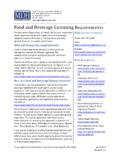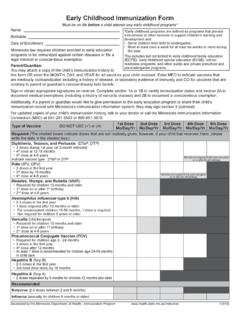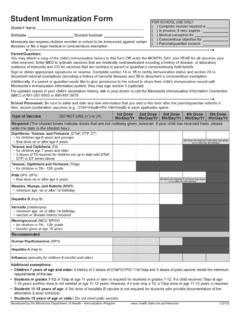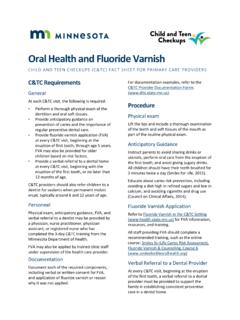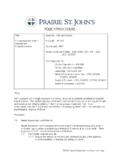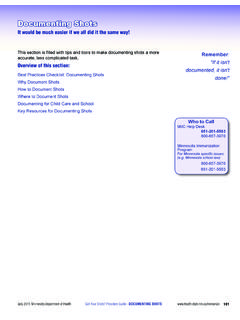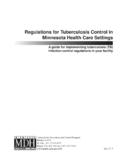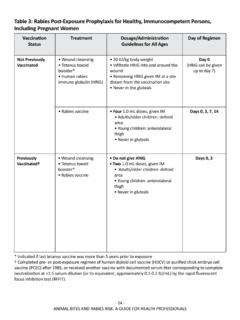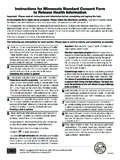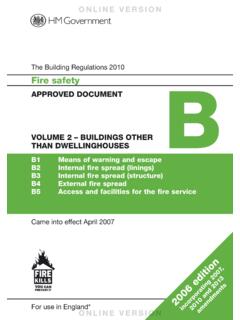Transcription of MAINTENANCE AND TESTING OF FIRE/SMOKE DAMPERS
1 Page 1 of 3. MAINTENANCE AND TESTING OF FIRE/SMOKE DAMPERS . Introduction In order to ensure that they will operate properly when needed, federal certification requirements mandate that fire and smoke DAMPERS in healthcare facilities undergo routine MAINTENANCE [see NFPA 101(12), Sections 18 and ]. Sec. of the 2015 Minnesota State fire Code [MSFC(15)] requires that openings protected by smoke DAMPERS be maintained in accordance with NFPA 105(2010). MSFC(15), Sec. requires that openings protected by fire DAMPERS be maintained in accordance with NFPA 80(2010). Applicable standards NFPA 101(12), Sec. requires that air conditioning, heating, ventilating ductwork and related equipment be in accordance with NFPA 90A, Standard for the Installation of Air-Conditioning and Ventilating Systems.
2 The 2012. edition of that standard is referenced in NFPA 101(12), Sec. Air duct service openings It's next to impossible to properly maintain your fire and smoke DAMPERS unless you have adequate access to them. To that end, NFPA 90A requires that service openings be provided in air ducts adjacent to each damper [see Sec. ]. Obviously, the openings need to be conveniently located and large enough to allow for MAINTENANCE and resetting of the devices [see Sec. ]. It's important to note that there could be times when it may be necessary to get two arms into the duct . While no specifics are spelled out in the standard, NFPA. 90A(12), Sec. offers the following guidance relating to service openings: o Where the size of the duct permits, access doors should be at least 18 inches x 16 inches in size.
3 O Where fire DAMPERS are too large to allow them to be reset and the fusible link replaced from outside the duct , the access doors should be increased to at least 24 inches x 16 inches in size to allow a person to enter the duct . o The doors for fire DAMPERS should be located so that the spring catch and fusible links are accessible when the damper is closed. o The doors should be located as close as practicable to the DAMPERS . o It's recommended that access doors be located on the underside of ducts rather than on the side. Other things to keep in mind NFPA 90A(12), Sec. requires that service openings be identified with letters at least inch in height indicating the location of the damper within. While inspection windows are allowed in air ducts (so long as they're glazed with wired glass), they do not replace the required access doors [see NFPA 90A(12), Sec.]
4 ]. Openings need to be provided in walls or ceilings to allow for access to the service openings in your air ducts [see NFPA 90A(12), Sec. ]. CAUTION: Care must be taken to ensure that any access panels or drop-in ceiling tiles used to provide this access do not reduce the fire resistance rating of your floor-ceiling or roof-ceiling assemblies. New installations To ensure that they function as required, all fire DAMPERS , smoke DAMPERS and ceiling DAMPERS must be operated prior to occupancy of any new construction [see NFPA 90A(12), Sec. ]. You'll want to make sure that such TESTING is included in the contract with your installer, along with some kind of written confirmation that the TESTING took place and the DAMPERS performed as required.
5 June, 2016. Page 2 of 3. MAINTENANCE NFPA 90A(12), Sec. requires that fire DAMPERS and ceiling DAMPERS be maintained in accordance with NFPA 80, Standard for fire Doors and Other Opening Protectives. NFPA 90A(12), Sec. references the 2010. edition of that standard. NFPA 90A(12), Sec. requires that smoke DAMPERS be maintained in accordance with NFPA 105, Standard for smoke Door Assemblies and Other Opening Protectives. NFPA 90A(12), Sec. references the 2010 edition of that standard. Inspection, TESTING & MAINTENANCE of fire DAMPERS NFPA 80(10), Sec. requires that each damper be tested and inspected 1 year after installation. NFPA. 80(10), Sec. requires that the test and inspection frequency then be every 4 years, except for hospitals, where the frequency is allowed to be every 6 years.
6 Provisions dealing with the inspection, TESTING and MAINTENANCE of fire DAMPERS can be found in NFPA 80(10), Sections and and include the following: All tests must be completed in a safe manner by personnel wearing personal protective equipment. Full unobstructed access to the fire or combination FIRE/SMOKE damper must be verified and corrected as required. If the damper is equipped with a fusible link, the link must be removed for TESTING to ensure full closure and lock-in-place if so equipped. The fusible link must be reinstalled after TESTING is complete. If the link is damaged or painted, it must be replaced with a link of the same size, temperature and load rating. The operational test of the damper must verify that there is no damper interference due to rusted, bent, misaligned or damaged frame or blades, or defective hinges or other moving parts.
7 The damper frame must not be penetrated by any foreign objects that would affect fire damper operations. The damper must not be blocked from closure in any way. All exposed moving parts of the damper must be dry lubricated as required by the manufacturer. If the damper is not operable, repairs must begin without delay. Following any repairs, the damper must be tested for proper operation. Periodic inspections, TESTING and MAINTENANCE of a combination FIRE/SMOKE damper must also meet the inspection, TESTING and MAINTENANCE requirements contained in Chapter 6 of NFPA 105. Inspection, TESTING & MAINTENANCE of smoke DAMPERS NFPA 105(10), Sec. requires that each damper be tested and inspected 1 year after installation and that the test and inspection frequency then be every 4 years, except for hospitals, where the frequency is allowed to be every 6 years.
8 Provisions dealing with the inspection, TESTING and MAINTENANCE of smoke DAMPERS can be found in NFPA. 105(10), Sections and and include the following: Care must be exercised that all tests are completed in a safe manner wearing the appropriate personal protective equipment. Full unobstructed access to the fire or combination FIRE/SMOKE damper must be verified and corrected as required. Where a fusible link is installed on a combination FIRE/SMOKE damper, the link must be removed for TESTING the damper for full closure simulating a fire condition per the requirements and frequencies of NFPA 80. The fusible link must be reinstalled after TESTING is complete. If the link is damaged or painted, it must be replaced with a link of the same size, temperature and load rating.
9 June, 2016. Page 3 of 3. Tests must be conducted with normal HVAC airflow. The operation of the damper must verify that there is no damper interference due to rust or bent, misaligned or damaged frame or blades, or defective hinges or other moving parts. The damper frame must not be penetrated by any foreign objects that would affect fire damper operations. The damper must be verified to not be blocked from closure in any way. Any reports of abrupt changes in airflow or noise from the duct system must be investigated to verify that it is not related to damper operations. All exposed moving parts of the damper must be dry lubricated as required by the manufacturer. If the damper is not operable, repairs must begin as soon as possible.
10 Following any repairs, the damper must be tested for proper operation. smoke damper actuation must be initiated at a time interval recommended by the actuator manufacturer. DOCUMENT your inspection, TESTING & MAINTENANCE In accordance with NFPA 80(10), Sections , and and NFPA 105(10), Sections , and , all inspections, TESTING and MAINTENANCE of DAMPERS is required to be documented, indicating the location of the damper, date(s) of inspection, name of inspector and deficiencies discovered. The documentation must have a space to indicate when and how the deficiencies were corrected. All documentation is expected to be maintained and made available for review by the AHJ. It is important that at least two people in your facility know where the documentation on your facility's FIRE/SMOKE DAMPERS is kept to increase the likelihood that it can be readily provided if requested during an inspection.
